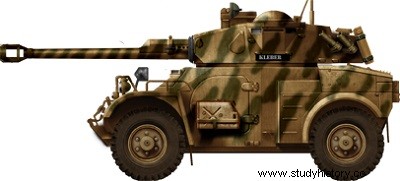
Type: light armored car.
Crew: 3 men.
Armament :a 90 mm gun; a coaxial 7.62 mm machine gun; one 7.62 mm on the turret roof (optional); 2 smoke launcher tubes on each side of the turret.
Shielding: from 8mm to 12mm.
Dimensions:
length (overall) :5.11m;
length (body): 3.79m;
width :1.97m;
height (including DCA machine gun):2.07 m.
Weight in combat order: 5.5 t
Engine :Panhard Model 4 MD 4 cyl. gasoline developing 90 hp at 4,700 rpm.
Performance:
road speed: 100 km/h;
autonomy 600 km;
vertical obstacle :0.3 m;
clean cut (with the use of a rail):0.8m:
slope: 60%.
Service time: introduced in 1961. Used by South Africa, Algeria, Angola, Saudi Arabia, Burundi. Congo, Ivory Coast. Éire, United Arab Emirates, Ecuador, Spain, Ethiopia. France, Upper Volta, Iraq, Kenya, Libya, Malaysia, Morocco, Mauritania, Nigeria, Portugal, Rhodesia. Rwanda, Senegal, Chad, Tunisia, Venezuela and Zaire.
During the 1950s, the standard armored car of the French army was the Panhard EBR-75 and it was realized during operations in Algeria, among others, that this vehicle was too heavy for many of the missions assigned to it. were assigned. The French therefore bought 200 British Ferret scout cars to ensure the transition, then undertook studies for a vehicle of the same type and in 1959, Panhard &Levassor of Paris completed the first prototype of the AML (light armored car). Two years later the machine was in service with the French army. Since that time, Panhard has released over 3,400 units and another 1,000 have been manufactured under license in South Africa, where the vehicle is known as the Eland.
One of the most widespread versions is the AML-90, armed with a 90 mm gun under turret which points in elevation from *15° to -8° and fires two types of ammunition:HÉAT (muzzle velocity. 760 m/sec) and HÉ (breezy). The HÉAT shell pierces 320 mm of armor at 0° incidence and 140 mm at 600° incidence; the useful range is 1,500 m. AML-90s from Israel and South Africa brought many Russian T-54 tanks to their knees. The HE shell has an initial speed of 650 m/sec. HEAT ammunition, like HE ammunition, is stabilized by fins.
The main armament comes with a coaxial 7.62 mm machine gun and an additional machine gun can be mounted on the roof of the turret for anti-aircraft defense (this feature is found in most members of the AML family). The AML-90 carries 20 rounds of 90 mm and 2,400 rounds of 7.62 mm.
The basic model of the AML can wade up to 1.1 m; a buoyancy kit can now be used on all members of the AML family, permanently. The vehicle is then propelled on the water by its wheels but it can also be equipped with a propeller to increase its speed.
One of the traditional disadvantages of wheeled vehicles compared to tracked ones is their relative awkwardness in crossing ground obstacles.
Also the AMLs carry steel rails fixed by a few bolts to the front of the body for transport. Once bolted end to end, these rails form a bridge which allows the AML to cross ditches and excavations.
The AML has many variants including the following gear. in service today:an anti-aircraft vehicle, with twin 20 mm guns and a total of 600 shells; the AML60-7, carrying a 60mm mortar and two twin 7.62mm machine guns; the AML-60-12, mounting a 60 mm mortar and a 12.7 mm machine gun;
the AML-60-20, still with the 60 mm mortar but supported this once with a 20 mm cannon;
finally, the AML 30, more recent armed with a 30 mm cannon HS 831 and a coaxial 7.62 mm.
Some AMLs were fitted with SS-11 anti-tank missiles to supplement their regular armament.
Some elements of AML vehicles are also used in the manufacture of the APC Panhard M-3 which, in some armies, often operates side by side with the AML.
